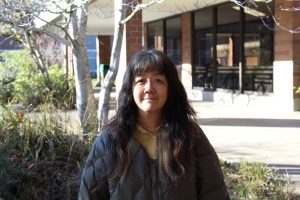By Eva King
Arts and Culture Editor

Head shot of Junko Photo by Carlos Rodriguez-Picazo
Originally from Tokyo, Japan, Clackamas Community College instructor Junko Iijima welds her culture into her work. Iijima teaches jewelry technique and metalsmithing classes on campus, and has her Master of Fine Arts degree in metalsmithing.
The Clackamas Print recently had the opportunity to talk to her about her history and the classes she teaches.
The Clackamas Print: When you were going to college, how did you decide to do metalsmithing for your MFA at University of Oregon?
Junko Iijima: I’m from Japan, and I’m still a Japanese citizen. When I came here, I was high school exchange student and I decided to stay here because I liked it so much. I went to State University of New York at New Paltz and I was interested in art but I was also interested in journalism because both my grandparents are journalists in Japan. Some class I did, they wanted me to do some back prop for some talent show or some kind of show. So I organized and did a big mural and everyone was like “Wow, you’re good at it”. And I’m like, “This is what I want to do.” So I decided to do art and I took all the courses. I like the metalsmithing because it was the most challenging. I graduated 1994 so back then, 30 years ago, metalsmithing was still relatively new. I felt like I was one of the pioneers of the field, and I got hooked.
TCP: Why did you decide to stay in Oregon?
Iijima: It’s closer to Japan. And beer was good. I love beer, IPA.
TCP: Why do you enjoy teaching at CCC?
Iijima: I like the department. People are really nice here. And students are more interesting here to me. You know, Pacific University, four year colleges, more students are coming straight from high school and you get to only work with certain age group of students. But here you have people who are retired or took a couple years off, people who have interesting experience in their life and coming to kind of share. I think I like that part the most.
TCP: What is the class structure of the jewelry making classes?
Iijima: I teach fall and spring, four credit courses. Mostly we work with jewelry making. We meet twice a week for three hours, but it’s ten weeks. I know at community college some people work and have a busy life. So I wanted to try to make sure that everybody can finish their work within class time, plus some outside homework kind of things. Four-credit courses most likely focus on fabrication of sheet metal and wire. In winter term, I have one credit course so if you don’t have the time to do four credit classes you can do one credit for the taste.
TCP: What would be something you would want to tell somebody about jewelry making or metalsmithing that they might not already know?
Iijima: It’s easy to say jewelry making because when you say jewelry making people think you’re going to be stringing beads or just slapping some stuff together. Metalsmithing is an ancient technique and it could have been done with very minimal tools. A lot of people think you need a big studio with all different tools, but it’s not true. People can make handmade beautiful objects to decorate their body, decorate the house, rather than purchasing from already made or manufactured mass produced pieces. I want people to think you can do anything if you want to do it.
TCP: I was taken by how it seems you use toys in some of your art. Why is that?
Iijima: To me it’s a cultural specimen, you know, pop culture specimen. When I came here 30 years ago, and I was put in West Virginia in this exchange student program, their motto was “You’re a little ambassador of Japan.” And I was 17, and I have to go into a place where nobody has ever seen Japanese person before. At that time, “Shogun” the show was just airing in 1987 and everybody thought Japanese people still live like that. But also a lot of people knew Hello Kitty so I was like ‘“Oh, here’s somebody I can connect,” you know? Hello Kitty is like modern pop culture. It’s not like those kimono wearing characters that you see in “Shogun.” I started collecting those little toys and samples of the pop culture of my time. That (faculty art) show I made Mickey Mouse ears, Pikachu’s ears and Miffy. I had like six different sets of ears just to mix up the pop culture with very Asian ornamentation to kind of challenge people’s perception.

Junko art in faculty art show. Photo by Jackson
TCP: Were there any artists that you’ve seen or met that have influenced a lot of your work?
Iijima: There are a few. Kiki Smith is one of the female artists who dealt with body parts a lot. I was also interested in the body because when I came here, I realized we all same under the skin. We are made up of same organs and same everything. It just the skin and the hair and eyes, those are the different things, but everything the same. Yayoi Kusama is an avant garde Japanese artist and she was doing some interesting work and I like her. Pop culture like Keith Haring, Andy Warhol, Basquiat, I like those guys. I was always a child of pop culture, so I was more interested in pop culture than old traditional work.
